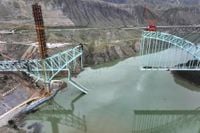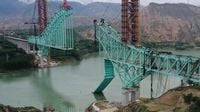In the early hours of August 22, 2025, a catastrophic accident shook northwest China as a major railway bridge under construction in Qinghai province collapsed, killing at least 12 workers and leaving four others missing. The incident, which unfolded around 3 a.m., has prompted a massive rescue operation and cast a spotlight on the risks and challenges associated with China’s ambitious infrastructure projects.
According to reports from the official Xinhua News Agency, the disaster struck when a steel cable snapped during a routine tensioning operation. Sixteen workers were on the bridge at the time. The sudden failure caused a central portion of the bridge to plummet into the Yellow River below, sending up a shower of sparks and water as captured in dramatic footage shared by local news outlets. Aerial photos distributed by Xinhua revealed a gaping void where a large section of the bridge’s distinctive curved aquamarine arch had once stood. A bent portion of the bridge deck now hangs precariously downward into the river, a haunting reminder of the tragedy.
The bridge, which was nearing completion, is a critical part of the Sichuan-Qinghai Railway—a project designed to connect the remote Tibetan Plateau with China’s rapidly expanding high-speed rail network. Spanning 1.6 kilometers (about a mile) and rising 55 meters (180 feet) above the surface of the Yellow River, the structure was envisioned as a symbol of engineering prowess and regional integration. Instead, it has become the focus of grief and urgent inquiry.
Search and rescue operations were launched immediately following the collapse, drawing on an impressive array of resources. As reported by China Daily and Sky News, the effort involved 27 boats, a helicopter, and five specialized robots. More than 800 personnel and 91 vehicles were mobilized to comb the river and surrounding area for survivors and the missing. The scale of the response underscores both the gravity of the incident and the logistical challenges posed by the bridge’s height and the river’s swift current.
State media and government officials have confirmed the grim toll: twelve workers lost their lives, and four remain unaccounted for as of the latest updates. The identities of the victims have not yet been released, but the tragedy has reverberated through the local community and beyond. Many families are left waiting anxiously for news of their loved ones, while rescue teams continue their painstaking search amid difficult conditions.
The cause of the collapse is under active investigation. According to Xinhua, authorities have described the incident as an accident, but the precise sequence of mechanical failures and human decisions leading up to the disaster remains unclear. Structural failures during tensioning operations are rare but can be catastrophic, especially in massive projects where the margin for error is slim. The snapped steel cable, a crucial component in distributing the bridge’s load, appears to have been the immediate trigger, but investigators will be looking closely at engineering designs, construction protocols, and maintenance records for any underlying issues.
The Sichuan-Qinghai Railway, of which the collapsed bridge is a part, has been heralded as a transformative development for China’s western regions. By linking the Tibetan Plateau to the national high-speed rail network, the project aims to spur economic growth, facilitate tourism, and improve access to remote communities. For years, China has invested heavily in such infrastructure, building railways, airports, and highways at a breathtaking pace. In some cases, these projects seemed to rise overnight, a testament to the country’s technical capabilities and centralized planning.
Yet, as The New York Times notes, the pace of construction has slowed in recent years amid economic headwinds and a real estate sector under strain. The government has become more cautious with infrastructure spending, prioritizing quality and safety alongside speed and scale. The Qinghai bridge collapse is likely to intensify scrutiny of construction standards and workplace safety across the industry.
Rescue workers and officials have been candid about the challenges they face. With the bridge deck suspended high above the river and debris scattered over a wide area, locating and recovering the missing workers is a daunting task. The use of advanced technology—including search robots and aerial surveillance—reflects both the complexity of the operation and the determination to leave no stone unturned.
In the aftermath, public reaction has been a mix of sorrow, frustration, and calls for accountability. Accidents of this magnitude are rare but not unprecedented in China’s infrastructure boom. Each incident raises questions about oversight, contractor qualifications, and the pressures of meeting ambitious deadlines. As one observer put it, "When you build at this scale and speed, every step must be flawless. One small mistake can have devastating consequences."
Government agencies have pledged a thorough investigation. The findings will likely shape not only the future of the Sichuan-Qinghai Railway but also broader policies governing construction safety and project management. Industry experts are already weighing in, suggesting that the collapse could lead to stricter inspections, revised engineering guidelines, and enhanced training for workers involved in high-risk operations.
Meanwhile, the families of the victims are left to mourn, and their grief is echoed by colleagues and friends across the region. The tragedy has also sparked a wider conversation about the human cost of progress. While infrastructure projects bring undeniable benefits, they also carry risks that must be managed with vigilance and care. For many, the image of the collapsed bridge arch—once a symbol of connection, now a stark reminder of loss—will linger long after the rescue boats and robots have left the scene.
As the search continues and investigations proceed, the Qinghai bridge collapse stands as a somber chapter in China’s ongoing pursuit of modernization. It is a moment for reflection, not only on what went wrong but on how to ensure that such tragedies are prevented in the future. For the workers who lost their lives, and for those still missing, the hope is that their sacrifice will lead to lasting improvements in safety and oversight, safeguarding the dreams and lives of those who build the nation’s bridges—literally and figuratively.

